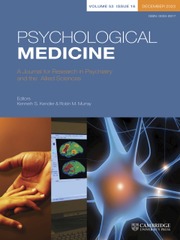Crossref Citations
This article has been cited by the following publications. This list is generated based on data provided by
Crossref.
Korndörfer, Sergio R.
Lucas, Alexander R.
Suman, Vera J.
Crowson, Cynthia S.
Krahn, Lois E.
and
Melton, L. Joseph
2003.
Long-term Survival of Patients With Anorexia Nervosa: A Population-Based Study in Rochester, Minn.
Mayo Clinic Proceedings,
Vol. 78,
Issue. 3,
p.
278.
Milos, Gabriella Franca
Spindler, Anja Margareta
Buddeberg, Claus
and
Crameri, Aureliano
2003.
Axes I and II Comorbidity and Treatment Experiences in Eating Disorder Subjects.
Psychotherapy and Psychosomatics,
Vol. 72,
Issue. 5,
p.
276.
Tozzi, Federica
Sullivan, Patrick F.
Fear, Jennifer L.
McKenzie, Jan
and
Bulik, Cynthia M.
2003.
Causes and recovery in anorexia nervosa: The patient's perspective.
International Journal of Eating Disorders,
Vol. 33,
Issue. 2,
p.
143.
Vitousek, Kelly M.
Gray, Jennifer A.
and
Grubbs, Kathleen M.
2004.
Caloric restriction for longevity: I. Paradigm, protocols and physiological findings in animal research.
European Eating Disorders Review,
Vol. 12,
Issue. 5,
p.
279.
González‐Pinto, Ana
Inmaculada, Failde
Cristina, Rodriguez
de Corres Blanca, Fernández
Sonsoles, Enjuto
Fernando, Ramírez
and
Purificacion, López
2004.
Purging behaviors and comorbidity as predictive factors of quality of life in anorexia nervosa.
International Journal of Eating Disorders,
Vol. 36,
Issue. 4,
p.
445.
Surgenor, Lois J.
Maguire, Sarah
and
Beumont, Pierre J. V.
2004.
Drop‐out from inpatient treatment for anorexia nervosa: can risk factors be identified at point of admission?.
European Eating Disorders Review,
Vol. 12,
Issue. 2,
p.
94.
Striegel‐Moore, Ruth H.
Franko, Debra L.
Thompson, Douglas
Barton, Bruce
Schreiber, George B.
and
Daniels, Stephen R.
2004.
Changes in weight and body image over time in women with eating disorders.
International Journal of Eating Disorders,
Vol. 36,
Issue. 3,
p.
315.
Agman, Gilles
Corcos, Maurice
Bochereau, Denis
Chambry, Jean
and
Jeammet, Philippe
2004.
Troubles des conduites alimentaires à l'adolescence.
EMC - Psychiatrie,
Vol. 1,
Issue. 1,
p.
1.
Holtkamp, K.
Hebebrand, J.
Mika, C.
Heer, M.
Heussen, N.
and
Herpertz-Dahlmann, B.
2004.
High serum leptin levels subsequent to weight gain predict renewed weight loss in patients with anorexia nervosa.
Psychoneuroendocrinology,
Vol. 29,
Issue. 6,
p.
791.
George, Louise
Thornton, Chris
Touyz, Stephen W
Waller, Glenn
and
Beumont*, Pierre JV
2004.
Motivational enhancement and schema-focused cognitive behaviour therapy in the treatment of chronic eating disorders.
Clinical Psychologist,
Vol. 8,
Issue. 2,
p.
81.
Wade, Tracey D
Treloar, Susan A
Martin, Nicholas G
Statham, Dixie
and
Heath, Andrew C
2004.
Monozygotic twin pairs discordant for lifetime anorexia nervosa: An exploratory investigation.
Australian Journal of Psychology,
Vol. 56,
Issue. 2,
p.
127.
Rø, Øyvind
Martinsen, Egil W.
Hoffart, Asle
Sexton, Harold
and
Rosenvinge, Jan H.
2005.
Adults with chronic eating disorders. Two-year follow-up after inpatient treatment.
European Eating Disorders Review,
Vol. 13,
Issue. 4,
p.
255.
Deter, HC
Schellberg, D.
Köpp, W.
Friederich, HC
and
Herzog, W.
2005.
Predictability of a favorable outcome in anorexia nervosa.
European Psychiatry,
Vol. 20,
Issue. 2,
p.
165.
Viricel, J.
Bossu, C.
Galusca, B.
Kadem, M.
Germain, N.
Nicolau, A.
Millot, L.
Vergely, N.
Lassandre, S.
Carrot, G.
Lang, F.
and
Estour, B.
2005.
Diminution de la mortalité et stabilité du taux de guérison dans le suivi de l’anorexie mentale.
La Presse Médicale,
Vol. 34,
Issue. 20,
p.
1505.
Bulik, Cynthia M.
Bacanu, Silviu‐Alin
Klump, Kelly L.
Fichter, Manfred M.
Halmi, Katherine A.
Keel, Pamela
Kaplan, Allan S.
Mitchell, James E.
Rotondo, Alessandro
Strober, Michael
Treasure, Janet
Woodside, D. Blake
Sonpar, Vibhor A.
Xie, Weiting
Bergen, Andrew W.
Berrettini, Wade H.
Kaye, Walter H.
and
Devlin, Bernie
2005.
Selection of eating‐disorder phenotypes for linkage analysis.
American Journal of Medical Genetics Part B: Neuropsychiatric Genetics,
Vol. 139B,
Issue. 1,
p.
81.
Birmingham, C. Laird
Su, Jenny
Hlynsky, Julia A.
Goldner, Elliot M.
and
Gao, Min
2005.
The mortality rate from anorexia nervosa.
International Journal of Eating Disorders,
Vol. 38,
Issue. 2,
p.
143.
Silberg, Judy L.
and
Bulik, Cynthia M.
2005.
The developmental association between eating disorders symptoms and symptoms of depression and anxiety in juvenile twin girls.
Journal of Child Psychology and Psychiatry,
Vol. 46,
Issue. 12,
p.
1317.
Weaver, Kathryn
Wuest, Judith
and
Ciliska, Donna
2005.
Understanding Women’s Journey of Recovering From Anorexia Nervosa.
Qualitative Health Research,
Vol. 15,
Issue. 2,
p.
188.
Bachner-Melman, Rachel
Zohar, Ada H.
and
Ebstein, Richard P.
2006.
An Examination of Cognitive Versus Behavioral Components of Recovery From Anorexia Nervosa.
Journal of Nervous & Mental Disease,
Vol. 194,
Issue. 9,
p.
697.
Hjern, Anders
Lindberg, Lene
and
Lindblad, Frank
2006.
Outcome and prognostic factors for adolescent female in-patients
with anorexia nervosa: 9- to 4-year follow-up.
British Journal of Psychiatry,
Vol. 189,
Issue. 5,
p.
428.




